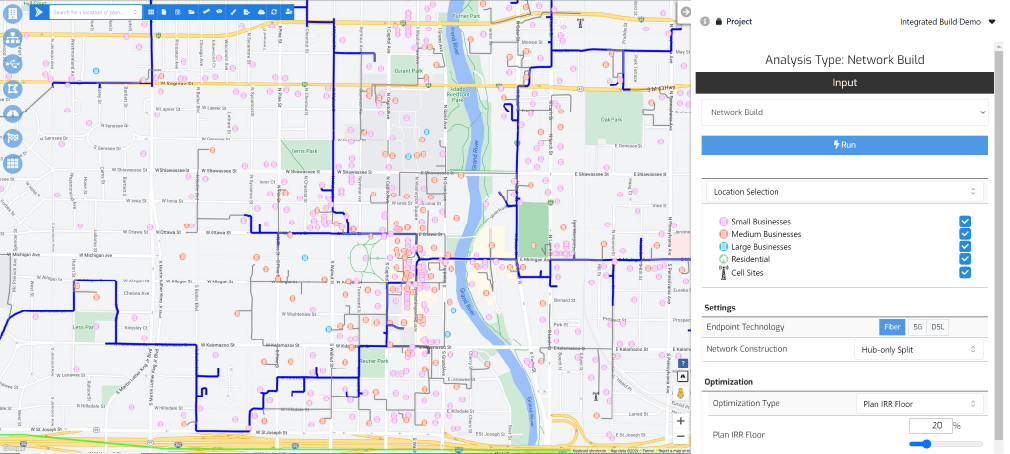Challenge
In a fiercely competitive broadband market, residential and commercial network operators striving to optimize their infrastructure must navigate growth objectives and financial return constraints. They face challenges in proactively planning for diverse location types, ranging from single-family units to small businesses, while ensuring future scalability for enterprise and tower locations.
For many, it is often difficult to design routes that serve all customer types efficiently, especially when dealing with smaller customer bases in commercial areas. This missed opportunity is further exacerbated when trying to model the expected revenue from new customers who subscribe to the service. However, a well-designed routing and expansion strategy can combat this by minimizing upfront costs, enabling a dig-once approach, facilitating timely customer connections, and effectively modeling expected revenue across location types.
Solution
Arrow by Altman Solon’s groundbreaking Probability Bubbles approach addresses these challenges. Probability Bubbles vary the routing strategy based on the characteristics of endpoints and network architecture. For example, lower-density large businesses and towers can be assigned to slack loops on the core network while single-family unit neighborhoods are fully built out. This approach ensures that resources are allocated judiciously, focusing on areas with higher customer potential while not neglecting locations with lower probability.
The critical advantage of Probability Bubbles is its flexibility. It allows network operators to prioritize locations based on their potential, creating a success-based model. This method enables a more targeted and adaptive expansion that reduces the distance to attractive endpoints and avoids speculative capex.
In the above example, Arrow models an expansion plan in a service area targeting all location types – residential single-family units, multi-family units, small businesses, large businesses, and cell towers. Spatial clusters are automatically created for designated location types (e.g., MFU or cell towers), and slack loops are placed to enable service to locations in the cluster given defined constraints (e.g., minimize new feeder fiber or place within 2,000 feet of location). In addition, within each slack loop cluster (or Probability Bubble), lateral fiber is simulated using all plants to provide a complete understanding of the cost to serve each location in the future, including the cost to connect.
On the revenue side, Arrow expanded to enable a better approach to model the potential revenue from locations encompassed by the Probability Bubble. The approach takes a ratio of the expected and median values – a Monte Carlo simulation – to model the distribution of potential outcomes. This ratio is used to apply a discount to the expected revenue from those locations and ensure that the business case for a single location with high value but lower probability is not overweighted, avoiding speculative capital deployment with a low probability of revenue generation.
Results
Arrow by Altman Solon partnered with a leading network operator and leveraged this new approach to proactively plan for all location types, resulting in a significant impact on its market expansion strategy. By intelligently placing slack loops, the operator more effectively competed for future demand outside its core FTTH business without materially changing the existing architectural approach or significantly increasing capex. In addition, the approach minimizes time spent on high-level design and enables a streamlined approach to downstream permitting and construction planning. The approach resulted in a >10% increase in the number of locations that can now be served while maintaining the operators’ financial returns. Previously, only residential location types were considered; however, a network plan for all locations significantly increased the number of residential locations that can be efficiently served (other location types offset the expansion cost to residential locations).
Future Applications
Arrow’s innovative approach paves the way for transformative applications in the future of fiber expansion:
- Operators can more efficiently and effectively serve potential near-net homes and businesses and consider them part of the business case for an enterprise or tower RFP.
- Shifting towards a more dynamic FTTH terminal placement, guided by Probability Bubbles, curtails unnecessary upfront speculative capital and allows for dynamic adjustments based on evolving customer demands.
- Utilizing Probability Bubbles as foundational data instead of unreliable underlying data (e.g., residential locations, competitors) enables reliable decision-making even in challenging data environments.
Arrow’s innovative approach transforms multi-location type fiber expansion planning. By proactively addressing the challenges associated with diverse location types, Arrow has optimized costs and future-ready infrastructure, enabling network operators to create more integrated and ROI-driven planning.



